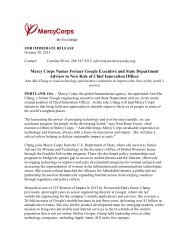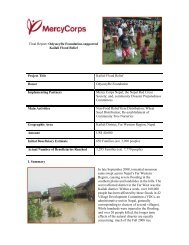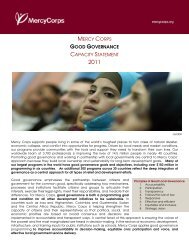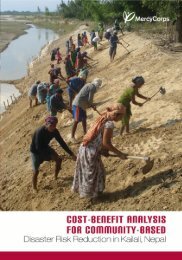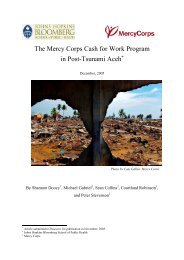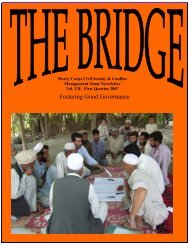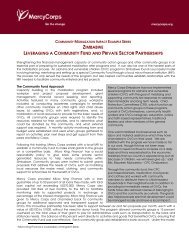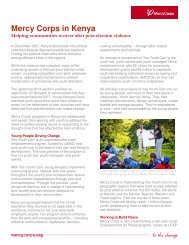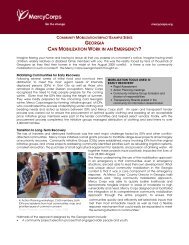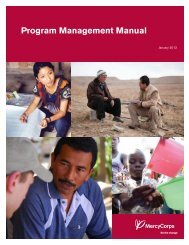SUSTAINABILITY FIELD STUDY - Mercy Corps
SUSTAINABILITY FIELD STUDY - Mercy Corps
SUSTAINABILITY FIELD STUDY - Mercy Corps
Create successful ePaper yourself
Turn your PDF publications into a flip-book with our unique Google optimized e-Paper software.
themselves had changed their attitudes toward communities or became more visible and active withinthe communities, perhaps as a result of one or more of the above explanations. Dodojonov MahatIbrov, the Chair of Government Administration in the Raion (district) government of Aravan, spoke ofthe change this way: “The greater collaboration through NGO partners has helped change attitudesand create a realization that government cannot contribute significant funds but that it can provideadvice and support.”Table 5: Explanations for Changes in Government InvolvementREASONNUMBER OF RESPONDENTSChanges within community 44Positive experience of working together 26Transitions within government personnel 17Changes in government policy 13Increased local use of government resources 10Government Became More ApproachableBoth CAIP and PCI actively encouraged interaction between local government and the CAGs,specifically for project planning, implementation, collection of contributions and sustainability planning.The study confirmed that CAG members were the greatest beneficiaries of improved governmentrelations and government involvement, with 73% stating that it is easier for them to approach localgovernment now than it was before <strong>Mercy</strong> <strong>Corps</strong>’ program. “Government interest increased withprojects. They tried to participate in meetings and activities even if they didn’t have resources. Beforepeople were afraid of government, but had to address them often during PCI projects and are nowless scared to approach government,” explained CAG member Abdurahimov Shaibek of PahtaabadCommunity in Northern Tajikistan.Of the general community members interviewed,58% also felt that attitudes toward local governmenthave changed in the past five years. While thereare many factors contributing to such changedattitudes, some community members specificallyattributed the change to their experience workingwith government on <strong>Mercy</strong> <strong>Corps</strong> projects, whileothers spoke about improved communication overall.Nizomov Mahmadzoir of Dombrachi community in theRasht Valley of Tajikistan explained the change thisway, “Before, the government did not participate inSANDY SHEARD, 2007 FOR MERCY CORPScommunity meetings. Now, we invite them and theyparticipate. They highly appreciate our activities with <strong>Mercy</strong> <strong>Corps</strong> (CAIP) and changed their attitudetoward us.” Koziev Muqomidding in the Havzak community in the Zarafshan Valley felt there was achange in the way community members approach local government following PCI, explaining“<strong>Mercy</strong> <strong>Corps</strong> taught people how to approach local government.”26Sustainability Field Study



